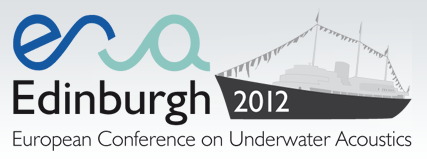
Abstract:
This paper aims at estimating the multipath structure of an underwater acoustic channel using a single vector sensor. The multipath structure of an underwater acoustic channel measured by a single hydrophone from broadband signals is used for source localization or environmental monitoring applying model based methods. Generally in a first step the relative delays between the different echoes impinging the hydrophone and their amplitudes are estimated, then those are compared with a propagation model outputs for a given set of input parameters. Usually this requires a number of time consuming propagation model runs and an optimization procedure. A vector sensor measures the pressure and the particle velocity, thus in addition to delays and amplitudes estimated by a hydrophone can potentially estimate the direction (azimuth and elevation) of the different echoes in an impulse response. This additional information can be used to
significantly reduce the number of propagation model runs and simplify the optimization procedure. Although, the estimate of the azimuth is relatively straightforward using a single vector sensor, the estimate of the elevation of the different echoes is difficult due to the signal bandwidth, low amplitude of the latter arrivals or sensitivity to phase errors of available devices, among others. This paper discusses the estimates of the direction of individual echoes observed in impulse responses gathered during the Makai'05 sea trial in the context of single vector sensor model based localization (azimuth, range and depth).